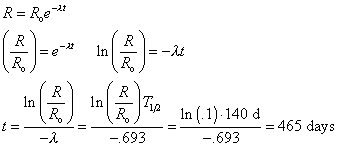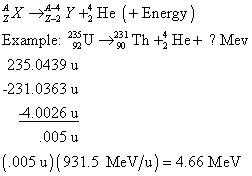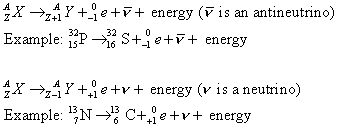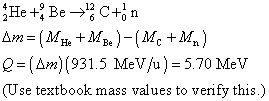
1. Terminology and Symbolism

Text (p. 967): "Rest energy" is Eo = mc2. If m is in kg, Eo is in joules.
Unified mass unit: 1 u = 1.660540 x 10-27 kg = 931.6 MeV/c2
Nutron
and electron masses are in the table of Physical Constants, inside text
fron cover..
Atomic
masses
(neutral atoms) are in Appendix B, pages 1119-1120
The mass
values in this table include the extranuclear electrons.
1. Binding Energy
The general principle for calculating the binding energy of a nucleus is based on conservation of energy:
(mass difference) = (total mass of component
parts)
- (mass of nucleus)
or
Dm = [Zmp
+ (A-Z)mn] -
mN
where mp is the proton
mass,
mn is the neutron mass and mN is
the
mass of the nucleus.
(The value to be used for mp
is that of the neutral hydrogen atom; this takes the electron masses
into
account.)
If the masses are in unified mass units (u), then the binding energy is
Eb = (Dm)(931.5 MeV/u)
Example. Calculate the binding energy of 2010Ne.
Z = 10 and A = 20, N = 10. The masses are: mp = 1.007825 u, mn = 1.008665 u, mN = 19.992435 u.
Dm = [(10)(1.007825 u) + (10)(1.008665 u)] - 19.992435 u = .1772465 u
Eb = (.172465 u)(931.5 MeV/u) = 161 MeV
The "binding energy per nucleon" is (161 Mev)/(20 nucleons) = 8.03 MeV/nucleon
2. Radioactive Decay

If there are No nuclei present at time t = 0, then the number N present at a later time t is given by:
N = Noe-lt
If the decay rate is Ro at time t = 0, then the decay rate R at a later time t is given by:
R = Roe-lt
The usual units for R are the curie
(Ci), 3.7 x 1010 decays/s and the becquerel (Bq),
1 decay/s.

Example
A radioactive sample has a half-life of 140 days. Calculate the time required for the activity to be one-tenth of its initial value.

3. Radiactive Decay Schemes
Conservation of nucleon number and conservation of charge must be satisfied.
(a) Alpha Decay

In this example, A = (A - 4) + 4 and Z = (Z - 2) + 2. Nuncleon number and charge are conserved.
(b) Beta Decay (positive and negative)

(c) Gamma Decay
A nucleus with excess energy (in an "excited state") emits the excess energy in the form of a gamma photon.

(d) Nuclear Reactions
Nucleon number, charge number, and mass-energy must all be conserved.
Example. An energetic alpha particle penetrates a beryllium nucleus,
forms an unstable carbon-13 nucleus,
which then disintegrates. The "Q" of the reaction is the energy
difference between the total mass of the
particles present before and after the reaction.

Example. Supply the missing product nucleus.
